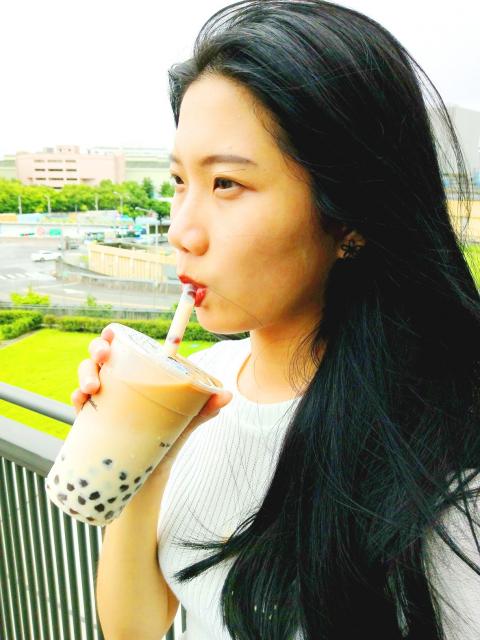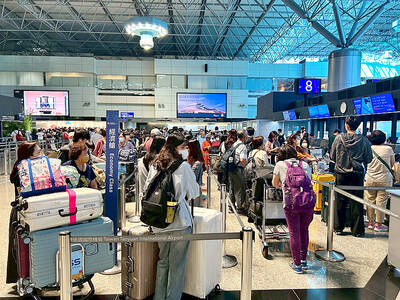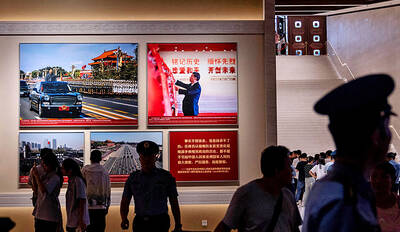Medical studies suggest that people should quit sugary drinks, which can lead to a higher risk of cardiovascular disease, diabetes and cancer.
UK-based journal The BMJ last month published a research paper, which linked the consumption of sweetened drinks to cancer.
The results show that a 100ml per day increase in the consumption of sugary drinks was associated with an 18 percent increased risk of cancer and a 22 percent increased risk of breast cancer, the study found.

Photo: Wu Liang-yi, Taipei Times
Academia Sinica researchers and National Taiwan University Hospital physicians in March also reported an association between pancreatic cancer and abnormal sugar metabolism.
Pancreatic cells can be damaged when a person’s blood sugar concentration is high, the team said, advising people to quit drinking sugary beverages.
Drinking sugary beverages for a long period could also cause tooth decay, metabolic disorders and obesity, the Ministry of Health and Welfare’s Health Promotion Administration (HPA) said.
Nearly 50 percent of overweight children are likely to become obese when they are adults, making them susceptible to diabetes, high blood pressure, hyperuricemia, osteoarthritis and cardiovascular disease, the HPA said.
Studies have also found that beverage stores use high-fructose corn syrup, which is artificially synthesized and cheaper, but consumption of it could result in heart disease, high blood fat, a fatty liver, gout, dementia and cancer, with children and teenagers at a higher risk of heart disease.
Taiwan’s signature drink, bubble tea, also called pearl tea (珍珠奶茶), often contains 440 to 550 calories, and those drinking a cup of pearl tea every day could gain 3.4kg to 4.3kg in two months, the HPA said.

Three batches of banana sauce imported from the Philippines were intercepted at the border after they were found to contain the banned industrial dye Orange G, the Food and Drug Administration (FDA) said yesterday. From today through Sept. 2 next year, all seasoning sauces from the Philippines are to be subject to the FDA’s strictest border inspection, meaning 100 percent testing for illegal dyes before entry is allowed, it said in a statement. Orange G is an industrial coloring agent that is not permitted for food use in Taiwan or internationally, said Cheng Wei-chih (鄭維智), head of the FDA’s Northern Center for

The Chinese military has built landing bridge ships designed to expand its amphibious options for a potential assault on Taiwan, but their combat effectiveness is limited due to their high vulnerability, a defense expert said in an analysis published on Monday. Shen Ming-shih (沈明室), a research fellow at the Institute for National Defense and Security Research, said that the deployment of such vessels as part of the Chinese People’s Liberation Army (PLA) Navy’s East Sea Fleet signals a strong focus on Taiwan. However, the ships are highly vulnerable to precision strikes, which means they could be destroyed before they achieve their intended

About 4.2 million tourist arrivals were recorded in the first half of this year, a 10 percent increase from the same period last year, the Tourism Administration said yesterday. The growth continues to be consistent, with the fourth quarter of this year expected to be the peak in Taiwan, the agency said, adding that it plans to promote Taiwan overseas via partnerships and major events. From January to June, 9.14 million international departures were recorded from Taiwan, an 11 percent increase from the same period last year, with 3.3 million headed for Japan, 1.52 million for China and 832,962 to South Korea,

REWRITING HISTORY: China has been advocating a ‘correct’ interpretation of the victory over Japan that brings the CCP’s contributions to the forefront, an expert said An elderly Chinese war veteran’s shin still bears the mark of a bullet wound he sustained when fighting the Japanese as a teenager, a year before the end of World War II. Eighty years on, Li Jinshui’s scar remains as testimony to the bravery of Chinese troops in a conflict that killed millions of their people. However, the story behind China’s overthrow of the brutal Japanese occupation is deeply contested. Historians broadly agree that credit for victory lies primarily with the Chinese Nationalist Party (KMT)-led Republic of China (ROC) Army. Its leader, Chiang Kai-shek (蔣介石), fled to Taiwan in 1949 after losing a